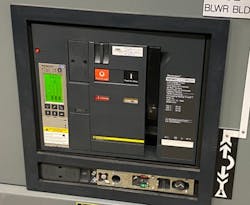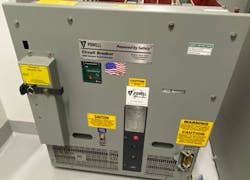Uncovering the Risks of Power Circuit Breaker Racking
Racking in or out a power circuit breaker is simple, right? Although this task sounds pretty straightforward in theory, that’s not always the case. In fact, during years of field work related to external electrical safety audits or while completing practical hands-on electrical safety program training in my electrical safety consulting practice, in general, I have found a lack of adequate formal training for “qualified persons” with new or updated electrical equipment technology related to power distribution electrical equipment.
Specifically, when capital project teams had successfully procured both low- and high-voltage arc-resistant electrical equipment, no formal training was typically provided. Where low- and high-voltage switchgear power circuit breakers had been provided, there was a lack of awareness of updated design elements related to manual racking or onboard remote racking (i.e., emergency extraction). Lastly, related to new high-voltage arc-resistant electrical equipment (i.e., switchgear) with embedded high-voltage motor starters, there was a lack of awareness of arc-resistant electrical equipment/type (e.g., IEEE C37.20.7 and specific Types) and for a high-voltage motor starter isolation a confusing mimic display on each motor starter where no formal training or procedure was in place.
Qualified persons (low-voltage and high-voltage qualified) were often not effectively trained concerning the isolation of new low- and high-voltage electrical power distribution equipment. Gaps in knowledge and a lack of competency on how to rack out or in a low-voltage power circuit breaker, how to complete a required “emergency extraction” racking out of a normally remotely racked high-voltage power circuit breaker when the onboard remote racking system fails, and isolation of a unique high-voltage motor starter were identified.
Is racking out or in a low- or high-voltage power circuit breaker simple? What about isolating a high-voltage motor starter? Are Kirk key interlocks involved? How many turns does it take to rack to “test,” and then how many additional turns to rack to “disconnected?” Are there special buttons the qualified person must push?
A critical component of risk related to the likelihood of occurrence related to energized electrical work tasks is ensuring the qualified person has the appropriate skills, knowledge, experience, and competency to perform the work. The employer must manage human performance and address the likelihood of human error. Racking out or in low- or high-voltage power circuit breakers and isolating unique high-voltage motor starters is not necessarily intuitive and simple. Qualified persons shall be suitably trained, follow a procedure, and have their competency validated before performing this type of work.
In the last decade, manufacturers have brought innovation to the industry with electrical equipment based on the concept of “safety by design/prevention through design (PtD)” related to the hierarchy of risk control methods to apply to an abnormal arcing fault and arc flash/electric shock. This has significantly benefitted the reduction of risk exposure to an abnormal arcing fault, arc flash, and electric shock. But has the qualified person received adequate training on this new electrical equipment? Do they make assumptions based on previous experience?
Depending on the manufacturer of low- or high-voltage power circuit breakers, this equipment may now have new unique interlocks. It may no longer be as simple as inserting the racking tool and racking the power circuit breaker out or in.
For high-voltage switchgear and power circuit breaker racking that has a provision for onboard racking only (with no through-door racking normally provided), what happens if this automated system fails? Has the qualified person been effectively trained to manually rack in and out the breaker? Is the manual “emergency extraction” racking simple? Is it the same as all the other power circuit breakers the qualified person has racked in or out in the past?
The problem
he manufacturer’s instructions and labeling on high-voltage electrical equipment related to the isolation of a high-voltage motor starter with an integral disconnect switch may also not be intuitive concerning the operation of the disconnect switch and closing an included grounding switch. Is the manual easy to read? Does it include graphics, flow charts, and pictures to assist in understanding and application? Does the manufacturer have an approved video that could be used for training or referenced in a procedure?
The likelihood of human error increases when qualified persons do not have appropriate knowledge, skills, and experience. In this case, they may make assumptions based on previous knowledge/norms and have difficulty deciphering symbology that is not standardized in the industry.
Since their 2015 editions, NFPA 70E and CSA Z462 have included detailed requirements and supporting information related to risk assessment. Two parameters are evaluated: potential severity of injury or damage to health and likelihood of occurrence.
Concerning the likelihood of occurrence, NFPA 70E [Sec. 110.3(H) Risk Assessment Procedure and Sec. 110.3(H)(2) Human Error] and CSA Z462 [Clause 4.1.7.8 Risk Assessment Procedure and Clause 4.1.7.8.3 Human Error] place focus on ensuring the evaluation of human error is appropriately addressed and managed for the risk assessment procedure completed.
The risk assessment procedure shall address the potential for human error and its negative consequences on people, processes, the work environment, and equipment relative to the electrical hazards in the workplace. The potential for human error varies with factors such as the complexity of work tasks and the work environment. For more information regarding human error see, Annex Q and Annex U in the respective standards.
A risk management process flowchart can be found in NFPA 70E Annex F [Risk Assessment and Risk Control] and CSA Z462 Annex F [Risk Assessment and Risk Control]. See the Flow Chart. After the risk assessment procedure is completed, the employer and employee must confirm a field validation of expected risk control methods.
The likelihood of occurrence and the potential for human error in new electrical equipment designs needs to be evaluated and appropriate risk control methods applied, administrative controls, awareness, training, and procedures.
As outlined through the content of NFPA 70E Annex Q or CSA Z462 Annex U, Table Q.5 or Table U.1 Error Precursor Identification and Human Performance Tool Selection, several error precursors can impact human error related to new electrical power distribution equipment designs with interlocks for racking in or out power circuit breakers, onboarding racking system automation, and the use of nomenclature for high-voltage motor isolations.
During three separate practical hands-on training sessions with experienced qualified persons, it was found that these individuals did not have appropriate knowledge and skills and were not competent concerning specific electrical equipment and manufacturer’s instructions for operating the electrical equipment for electrical equipment isolation. This is critically important to ensure the qualified person’s residual risk is managed and defendable when they are establishing electrically safe work conditions.
During the design basis memorandum (DBM) phase of a power system design, all available hierarchy or risk control methods shall be considered for electrical safety, and a cost-benefit analysis completed. What is lacking is ensuring that the capital project has funding available to provide technical skills training to qualified persons on the maintenance team on the new technology or updates to existing technology.
Arc-resistant electrical equipment designs have evolved and can also include the provision of remote power circuit breaker racking from an externally located panel. It is also important that the qualified person understand that the nameplate shall indicate the metal-clad switchgear is approved arc-resistant electrical equipment.
If automation of power circuit breaker racking is included, it can provide additional mechanical complexity and may be subject to failure. Manufacturers will include a provision for “emergency extraction of a power circuit breaker.” Is the qualified person appropriately trained and competent when the onboard automated racking system fails?
Training for a qualified person needs to include technical skills training related to any electrical equipment that will be worked on. If there are gaps in knowledge due to lack of this training, it can lead to uncertainty and increased likelihood of human error (see Table).
How do we solve the problem?
Human error probability needs to be managed through the application of risk control methods.
Power circuit breaker racking (both low- and high-voltage) is not necessarily intuitive. New power circuit breakers may include additional interlocks to be actuated to allow for insertion of the racking tool, racking the power circuit out or in, to the test position, and racking the circuit breaker out to the disconnected position. Symbology and nomenclature used may not be consistent with what the qualified person has been trained to understand.
Eliminating exposure by providing onboard motorized racking of high-voltage power circuit breakers eliminates exposure to arc flash, but what is required to “emergency extract” a power circuit breaker when the remote racking system fails? Knowledge, skills, experience, training, and the use of an “emergency extracting racking procedure” will drive the probability of human error down or eliminate it.
High-voltage motor starters and isolation may not be intuitive and will be confusing with the use of unfamiliar symbology and nomenclature. Specific manufacturer’s operating instructions require training, and the use of an electrical safe work procedure will ensure human error probability is managed. Knowledge retention and knowledge transfer are other positive outcomes of developing and using an electrically safe work procedure. The qualified person must be trained on, follow a procedure, and be competent for each manufacturer’s operating instructions with enhanced safety features. The bottom line is retraining or additional training may be required at regular intervals to maintain competency.
Training Requirements
NFPA 70E [Sec. 110.4(A)(3)], Standard for Electrical Safety in the Workplace, and CSA Z462 [Clause 4.1.8.1.4 Retraining and Additional Training] outline prescriptive training requirements for a “qualified person” to receive periodic retraining in safety-related work practices and applicable changes to the standards at intervals not to exceed three years to maintain an appropriate level of awareness. Additional training shall be required if:
- Supervision or annual inspections indicate that the worker is not complying with safety-related work practices;
- New technology, new types of equipment, or changes in procedures necessitate the use of safety-related work practices that are different from those that the worker would normally use;
- The worker needs to employ tasks that are performed less often than once per year;
- The worker needs to employ safety-related work practices that are not normally used during the worker’s regular duties; or
- The worker’s job duties change.
About the Author
Terry Becker, P.Eng
Terry Becker, P.Eng., CESCP, IEEE Senior Member is the first past vice-chair of the CSA Z462 Workplace Electrical Safety Standard Technical Committee and is currently a voting member and Clause 4.1 and Annexes working group leader. He is also a founding member and voting member on the CSA Z463 Maintenance of Electrical Systems Standard and a voting member of the IEEE 1584 Guide for Performing Arc-Flash Hazard Calculations. Terry is also a voting member of the CAN/ULC S801 Electrical Utility Workplace Safety Standard for Utility Generation, Transmission, and Distribution. He has presented at conferences and workshops on electrical safety in Canada, the USA, Italy, India, and Australia. Terry is a Professional Engineer in the Canadian provinces of BC, AB, ON, and PEI. He is an electrical safety specialist and management consultant at TW Becker Electrical Safety Consulting, Inc. (www.twbesc.ca) and can be reached at 1-587-433-3777 or by email [email protected].







